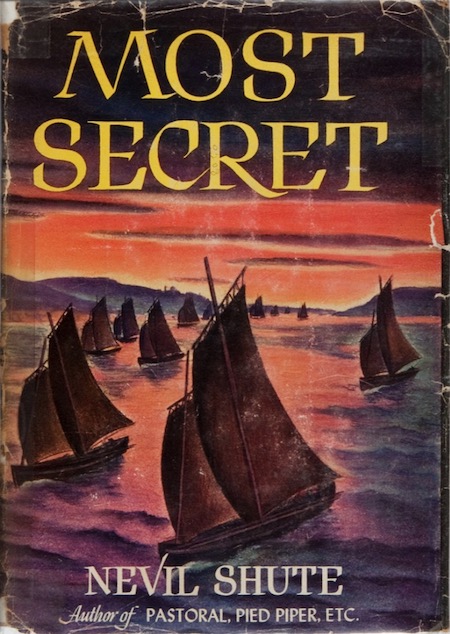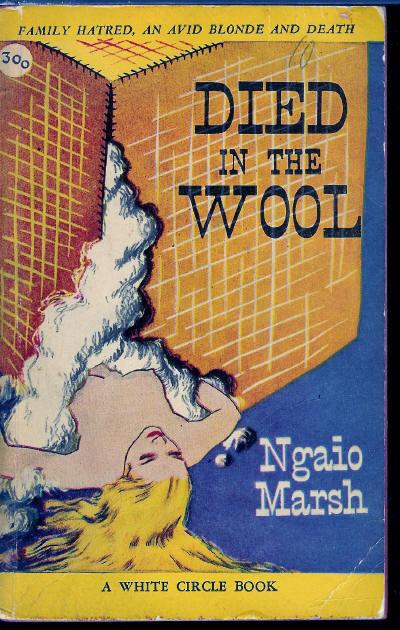10 Best Adventures of 1945
By:
April 17, 2015
Seventy years ago, the following 10 adventures — selected from my Best Forties Adventure list — were first serialized or published in book form. They’re my favorite adventures published that year.
Note that 1945 is, according to my unique periodization schema, the second year of the cultural “decade” know as the Nineteen-Forties. The transition away from the previous era (the Nineteen-Thirties) begins to gain steam….
A good year for talking-animal adventures…
- E.B. White’s children’s fantasy adventure Stuart Little. A mouse born to a human family races a sailboat in Central Park, gets shipped out to sea in a garbage can, and sets out — several years before Kerouac’s On the Road — on a cross-country odyssey. The book was criticized, at the time, by the New York Public Library’s influential children’s lit expert for being nonaffirmative, inconclusive, and unfit for kids.
- Murray Leinster’s science fiction adventure First Contact. A novella, published in Astounding Science Fiction, and retroactively awarded a Hugo Award (in 1996). When a scientific expedition sent to the Crab Nebula meets an alien crew of astronauts on a similar mission of exploration, neither team is sure how to react. While both crews are eager to acquire the others’ technology, and to establish a mutually beneificial relationship, they’re mutually suspicious, too. Fun fact: Leinster coined the phrase “first contact.”
- Helen MacInnes’s prison-break adventure Horizon. Although not quite as exciting and satisfying as her best-known novels from the same era, Horizon is — like Above Suspicion, Assignment in Brittany, and While Still We Live — a suspenseful story about an Allied agent operating in Europe against the Nazis. Freed from an Italian prison camp, British soldier Peter Lennox joins a band of resistance fighters helping to pave the way for a crucial Allied push. After an action-packed first chapter or two, the book slows down… in an interesting way, one which demonstrates how much waiting is involved in espionage work, and how taxing it is.
- C.S. Lewis’s dystopian science fiction adventure That Hideous Strength. Operating under the influence of Olaf Stapledon and David Lindsay, before he wrote The Chronicles of Narnia, Oxford don C.S. Lewis wrote a trilogy of theological science fiction yarns. That Hideous Strength, in which N.I.C.E., an ostensibly scientific institute, turns out to be a front for demonic entities plotting to ravage the Earth (if they can just locate and possess the body of Merlin, the Arthurian enchanter who lies in suspended animation), is the series’ final installment.
- C.S. Forester’s historical sea-going adventure Commodore Hornblower. Published in the UK as The Commodore. In 1812, Horatio Hornblower — protagonist of a long-running series of novels and stories (1937–67) — is put in command of a squadron and sent to the Baltic; he is tasked with bringing Russia into the war against Napoleon. Using naval mortars, he destroys a French ship, then defends Riga against a besieging French force. Tsar Alexander I and Carl von Clausewitz make appearances. Fun fact: Hornblower’s implied sexual encounter with a Russian Countess caused controversy when the story first appeared in the Saturday Evening Post.
- George Orwell’s dystopian talking-animal adventure Animal Farm. After the pigs Snowball and Napoleon lead a revolution against the drunken farmer Mr. Jones, they rename their home Animal Farm — a worker’s collective whose creed is “All animals are equal.” However, Napoleon and Snowball struggle for preeminence. Napoleon seizes power, then purges the farm of his rival’s supporters; he also begins to enrich himself and his cronies. Eventually, Napoleon decrees that “All animals are equal, but some animals are more equal than others.” The author was writing not an anti-utopian satire of the Stalin era, but rather an anti-anti-utopian lament for the missed opportunity offered by the Russian Revolution of 1917.
- Dino Buzzati’s talking-animal adventure The Bears’ Famous Invasion of Sicily. One winter when their food supply runs out, the bears of Sicily descend from their mountain and enter into a pitched battle with the forces of the Grand Duke of Sicily. The bears capture the capital city… where their king, Leander, discovers his long-lost son, who was kidnapped and forced to perform for Sicilian audiences. All’s well that ends well… except that King Leander is sorry to see his bear subjects become ever more human-like. After a coup attempt by his corrupted chamberlain, Leander urges the bears to leave the city behind forever and return to their simple, bear-ish way of life.
- Nevil Shute’s WWII adventure Most Secret. After France signs an armistice with Germany in June 1940, Commander Martin of Britain’s Royal Navy oversees a quixotic commando mission intended to inspire the French populace. A small group of British officers, each of whom has experienced a terrible loss at the hands of the Germans, are armed with a terrible new weapon — a flame thrower — and sent on a series of daring raids, assisted by the crew of a Breton fishing boat, into occupied France. Written in 1942, this is a work of propaganda… but because it’s written by Nevil Shute, it’s emotionally engaging. We learn the back story of each character, and come to care about them; there’s also a romance subplot between a hy scientist and an impressive young woman serving in the Wrens. Shute could be a bit of a mystic — think of An Old Captivity (1940), for example, or Round the Bend (1951) — and in this novel, there is a pronounced theme around the cleansing properties of fire. But you can ignore all of that, and enjoy the daring exploits of the crew of the Genevieve. Fun facts: During the war, Shute served in Royal Navy’s Directorate of Miscellaneous Weapons Development, and the book is full of realistic details — everything from the mechanics of the flame thrower, and how it is fitted to the fishing boat, to bureaucratic interaction between services.
- Ngaio Marsh’s crime adventure Died in the Wool. In the 13th installment (of 32) in Marsh’s classic Roderick Alleyn series, we find the gentleman detective Alleyn doing counterespionage work in New Zealand. Fifteen months after Flossie Rubrick, MP, one of the most formidable women in New Zealand, turns up at an auction packed inside one of her own sheep farm’s bales of wool, Alleyn investigates. His detecting is founded upon stories told him by the chief witnesses in the case. Fun fact: Marsh is considered one of the five Golden Age “Queens of Crime” alongside Agatha Christie, Dorothy L. Sayers, Gladys Mitchell, and Margery Allingham.
- Tove Jansson’s fantasy adventure The Moomins and the Great Flood. The first installment in the Finnish author’s beloved Moomintroll series! Moominmamma and Moomintroll search for Moominpappa; along the way, they adopt a little creature (later named Sniff), encounter a giant swamp serpent and an ant-lion, and join a group of Hattifatteners about to set sail. It’s all very Nordic: When Moominmamma falls into despair, at one point, everyone else gets gloomier and gloomier. With the help of a marabou stork, they also find Moominpappa’s house, which was carried away by a flood to a small valley — where they settle.










Also! I must mention the 1945 collection The Pocket Book of Adventure Stories, edited by Philip Van Doren Stern. I read it as an adolescent many times. Stories include: Hemingway’s “Fifty Grand,” Steinbeck’s “Flight,” Somerset Maugham’s “Red,” Richard Connell’s “The Most Dangerous Game,” and other classics.
Let me know if I’ve missed any 1945 adventures that you particularly admire.
JOSH GLENN’S *BEST ADVENTURES* LISTS: BEST 250 ADVENTURES OF THE 20TH CENTURY | 100 BEST OUGHTS ADVENTURES | 100 BEST RADIUM AGE (PROTO-)SCI-FI ADVENTURES | 100 BEST TEENS ADVENTURES | 100 BEST TWENTIES ADVENTURES | 100 BEST THIRTIES ADVENTURES | 75 BEST GOLDEN AGE SCI-FI ADVENTURES | 100 BEST FORTIES ADVENTURES | 100 BEST FIFTIES ADVENTURES | 100 BEST SIXTIES ADVENTURES | 75 BEST NEW WAVE SCI FI ADVENTURES | 100 BEST SEVENTIES ADVENTURES | 100 BEST EIGHTIES ADVENTURES | 75 BEST DIAMOND AGE SCI-FI ADVENTURES | 100 BEST NINETIES ADVENTURES (in progress) | 1994 | 1995 | 1996 | 1997 | 1998 | 1999 | 2000 | 2001 | 2002 | 2003 | NOTES ON 21st-CENTURY ADVENTURES.
